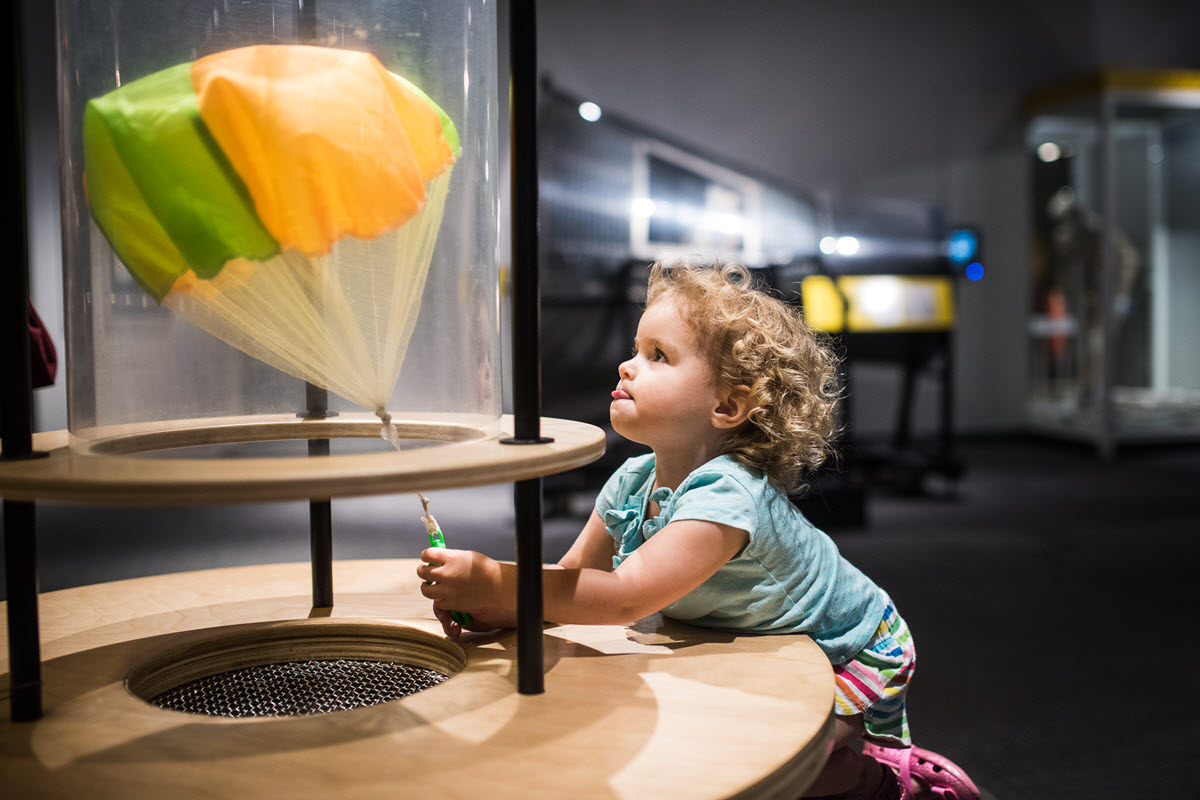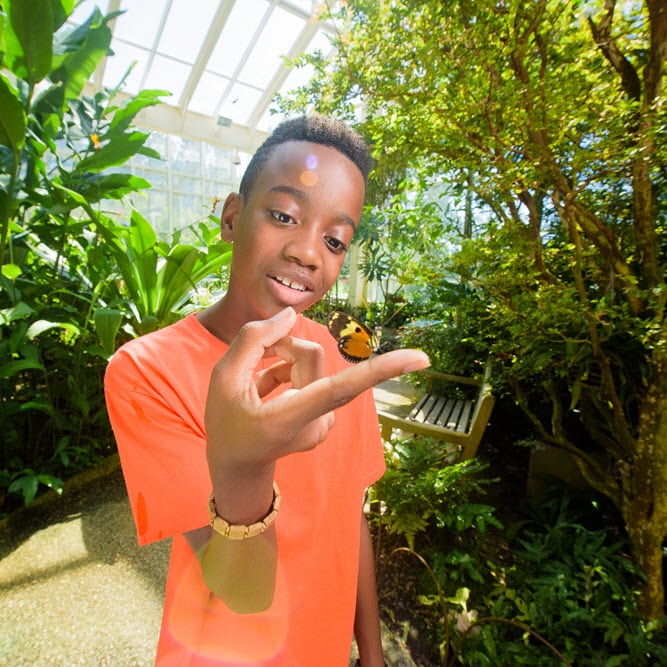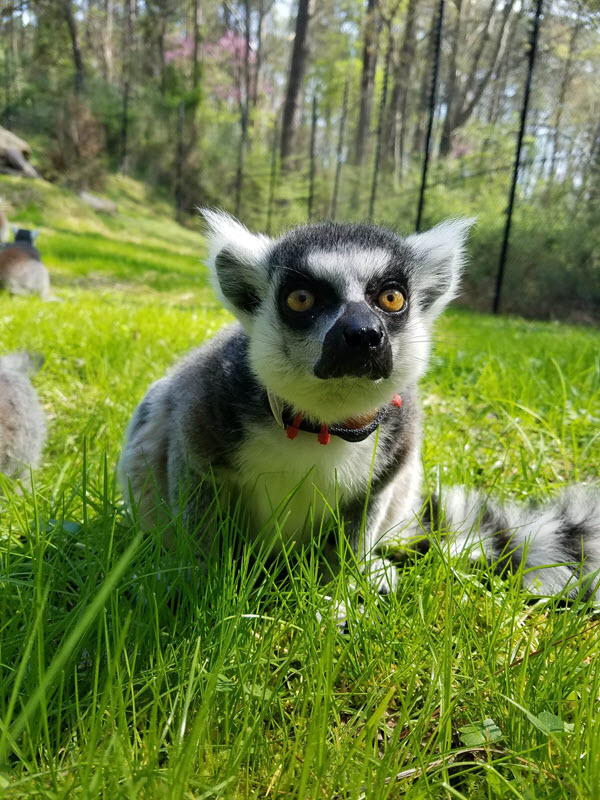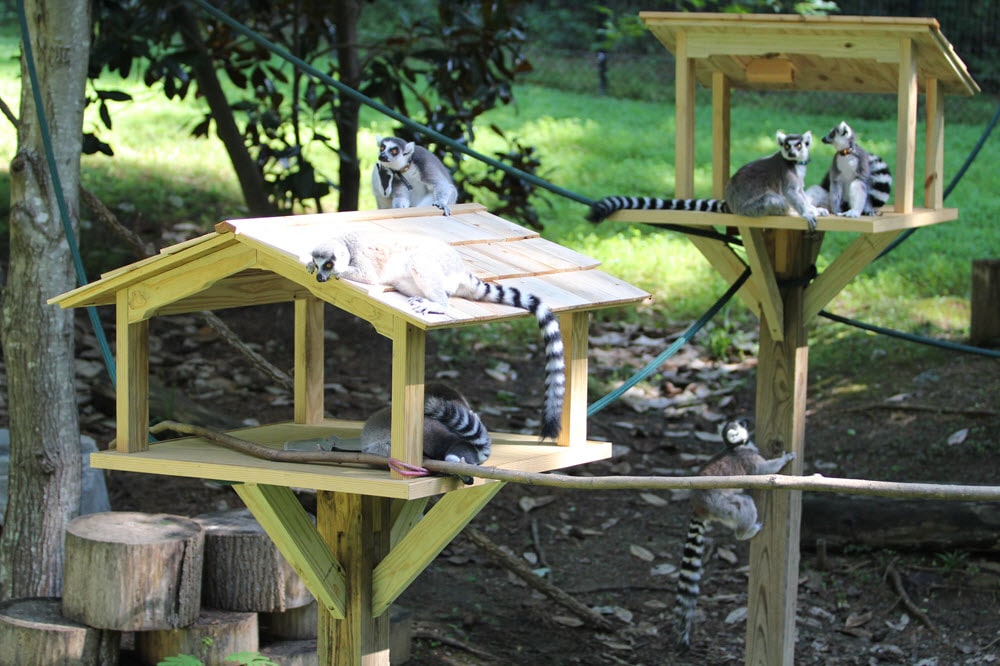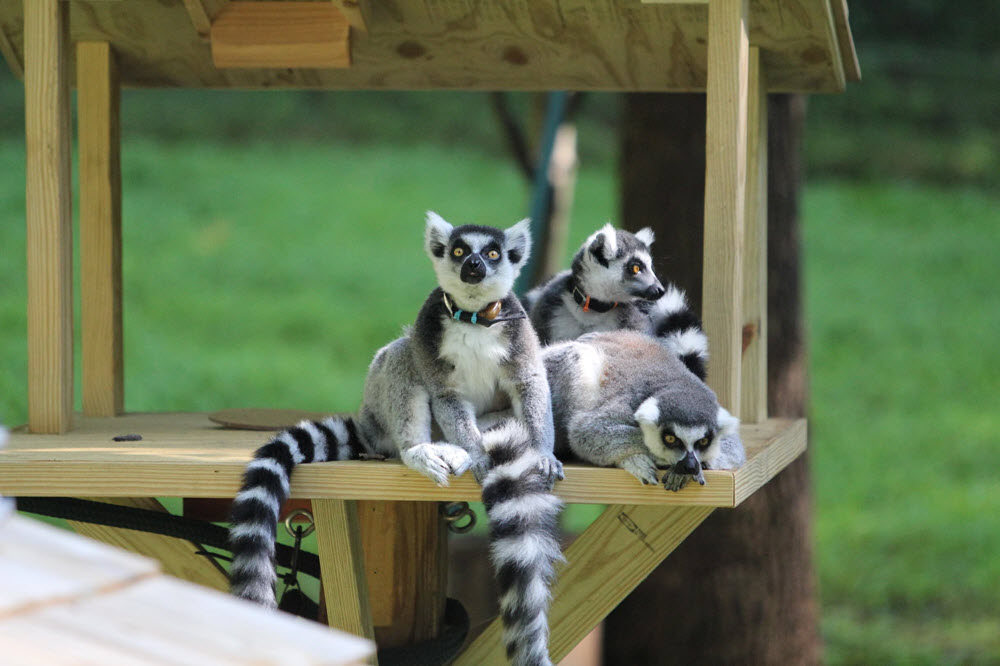For some, a day at the museum might sound a little boring. This is not the case with the Museum of Life and Science in Durham, where around every corner there’s a new adventure. This family favorite attraction is full of adorable animal sightings, educational moments, and unique experiences.
- Explore the Wild: Six-acre habitat with viewing deck for four black bears and guest-controlled cameras for rare red wolves.
- Insectarium & Magic Wings: 35-foot glass conservatory filled with hundreds of tropical butterflies and interactive insect exhibits.
- Hands-on learning: Launch Lab, weather exhibits, sound garden, sailboat pond, and playgrounds for interactive STEM play.
- Dinosaur Trail & farm: Life-sized dinosaur replicas and fossil digs, plus a Farmyard with daily up-close animal programs.
By the end of the day, your littlest ones are sure to be worn out from all of the excitement. Even a too-cool teenager can’t deny the fun of watching a black bear lounge in the sun. The whole family is bound to enjoy this museum.
If you’ve never paid a visit to the Museum of Life and Science, we’ve got all of the details you’ll need to know. Check out some of the popular exhibits at the museum below.

Explore the Wild: Mimi is one of four black bears living at the museum. An observation deck overlooking their habitat offers the best views.
Wild Adventures with Black Bears & Red Wolves
The Museum of Life and Science is an animal lovers’ dream come true! Throughout the museum, there are many different animal-centric exhibits. The “Explore the Wild” exhibit features a few different wild animals. This section of the museum is a 6-acre woodland habitat that also features wetlands.
There are four black bears on site. These bears can be viewed from an observation deck. Mimi is the oldest bear at the museum. She was born in 2004 and rescued from unhealthy living conditions. Since she was too friendly to be re-released into the wild, she was rehomed to the museum in 2006. Virginia, Gus, and Yona are the other three bears, each coming to the museum after being rescued and determined unfit for wildlife release.
Due to the NC weather, it never gets quite cold enough for the bears to fully hibernate, so no matter what time of year you visit, you should be able to spot the bears from the deck.

Two red wolves, Eno and Ellerbe, are part of the Explore the Wild exhibit. Their wolf den is tucked into an old rock quarry near a pool and waterfall.
In addition to the bears, the Explore the Wild exhibit also features red wolves. The museum is home to two red wolves. As one of the rarest animals in the world, these wolves are important ambassadors for the Red Wolf Species Survival Program.
The wolves’ habitat includes a pool with a waterfall and a covered den. A rock quarry wall is also included to give the beautiful animals a climbing challenge. Since it may be more difficult to see the red wolves while visiting, there are guest-controlled cameras on site for up-close views.
Creepy Crawlers and Magical Butterflies at the Insectarium
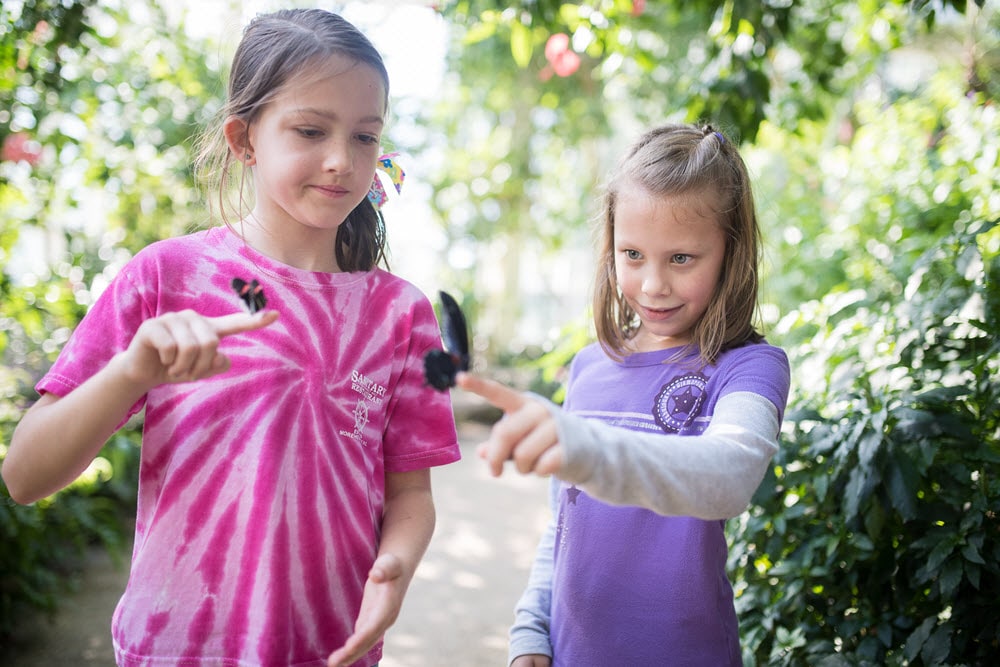
Experience the Magic Wings Butterfly House. The 35-foot glass walls enclose one of the largest conservatories on the East Coast.
Slightly smaller than the bears and wolves in the Explore the Wild exhibit, the insectarium and butterfly house feature an assortment of insects from around the world.
The Magic Wings Butterfly House is a mystical experience that allows visitors to walk through a 35-foot tall glass conservatory filled with plants and beautiful winged creatures. This butterfly house is one of the largest on the East Coast! As you walk through the building, you’ll be surrounded by hundreds of tropical butterflies. Using the guides provided, family members can challenge each other to try and identify every species in the house. Visitors can also spot tropical plants and a few different bird species.
The insectarium offers an up-close and personal look at invertebrates. From spiders to bumblebees, guests can learn all about the life cycle of a bug. While most of these crawlers are inside glass cases, the Giant Orb Weaver spiders are in an open-air exhibit. Don’t worry, these spiders won’t leave their web as it has everything they need!
Learn About Farmyard Friends
For a look at less exotic animals, kids might love a stop by the Farmyard exhibit. Here, donkeys, alpacas, miniature cattle, and more can be found.
Each day, visitors can get an even closer look at farm life with the “Farmyard Up-Close” program. Hosted at 4:30 pm daily, the animal keepers will care for the animals, prepare them for the night to come, and answer questions of their guests.
An Up-Close Look at Lemurs
The museum’s lemur exhibit houses seven ring-tailed lemurs. These adorable animals are known to play on an interactive playground in their home, so you’ll likely catch them socializing. The lemurs can often be found running along the balancing ropes or climbing on the structures built specifically to challenge and entertain them.
Ring-tailed lemurs are best known for their black and white striped tails. The seven lemurs at the museum are part of the Ring-Tailed Species Survival Plan and are cared for and studied to ensure genetic diversity.
Similar to the wolf exhibit, there are guest-controlled cameras on site. This means that you don’t have to worry about not getting a chance to see these social, adorable animals on your visit.
Travel Back in Time
For those who love the “animals” who roamed our planet millions of years ago, the dinosaur trail exhibit is a must-see. This outdoor section of the museum takes guests back in time to the Cretaceous period.
Along the Dinosaur Trail, you’ll get a chance to feel what the skin of a dinosaur might have felt like. Or, get hands on experience as a paleontologist as you dig for real marine fossils. The trail passes over a dozen life-sized replicas of dinosaurs including an early relative of the T. Rex, a Troodon, and a Parasaurolophus.
Learn While You Play
This museum isn’t only about animal adventures, though there are plenty of animals to see! Both the outdoor and indoor sections of the museum offer many hands-on exhibits. These fun experiences teach about everything from weather to space.
Inside, you’ll find a launch lab where visitors can use common materials to learn about gravity and airflow. Giant wind tubes with parachutes and paper airplane thrusters give a hands-on scientist experience in the Launch Lab.
The weather exhibit takes “hands-on” to a whole new level! Visitors can put their arms through a bowl full of clouds and can get up-close and personal with a 14-foot tall tornado.
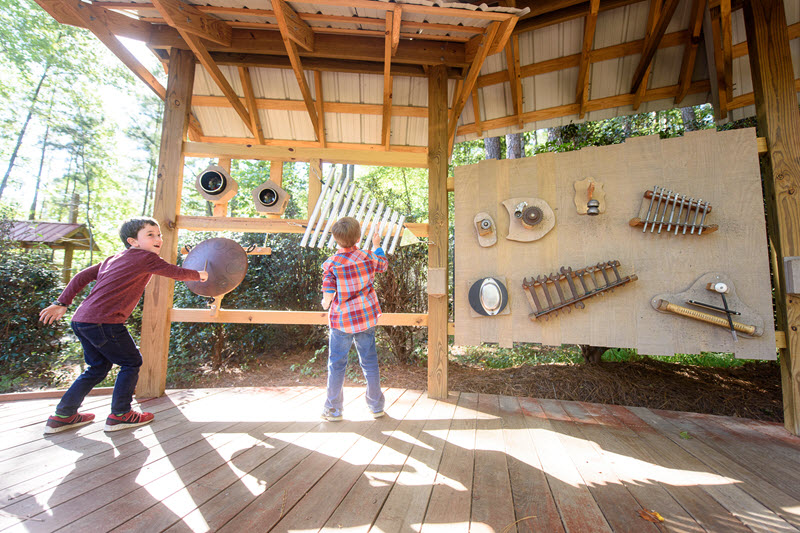
Calling all budding Beethovans! Let the kids get the wiggles out in the Sound Garden. While they compose their masterpiece, Carolina Traveler recommends sending your wingman to Elements Coffee Bar and Sprouts Cafe. You're welcome.
Outside, the sound garden lets kids make their own music. These unique musical instruments can help the young ones in your family to develop fine motor skills.
Learn more about the wind with a trip to sailboat pond. Here, guests can set up their own sailboat and drive it around a 5,000-square foot pond.
Kids will also love playing in the various playground exhibits such as the mist field, gateway park, or hideaway woods.
Final Tips for Visiting the Museum of Life and Science
The Museum of Life and Science is open Wednesday through Sunday from 10 am – 5 pm and is located just outside of downtown Durham.
General admission cost is $23; Seniors and US Military is $21; Children ages 3-12 is $18; Children under 3 are free. Members receive free admission all year long and early access (9 am). Various membership levels can be found here.
Throughout the year, the museum offers unique experiences including summer camps, holiday events, and classes. Plus, you can plan a birthday party on site! On regularly scheduled Durham Community Days each year (check the site for updates) residents of Durham County can get in free by showing their residency with ID.
Elements Coffee Bar and Sprouts Cafe offer tasty food options during your visit and picnic tables can be found throughout.
The Museum of Life and Science is one of North Carolina’s top destinations for families and shouldn’t be skipped when you’re in the area! Be sure to pay a visit and share your experience with us by tagging @carolinatravelr on Instagram.
The images used in this article were taken before the pandemic. The Museum of Life and Science requires guests to wear a mask and follow social distancing rules. Stay safe.

